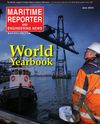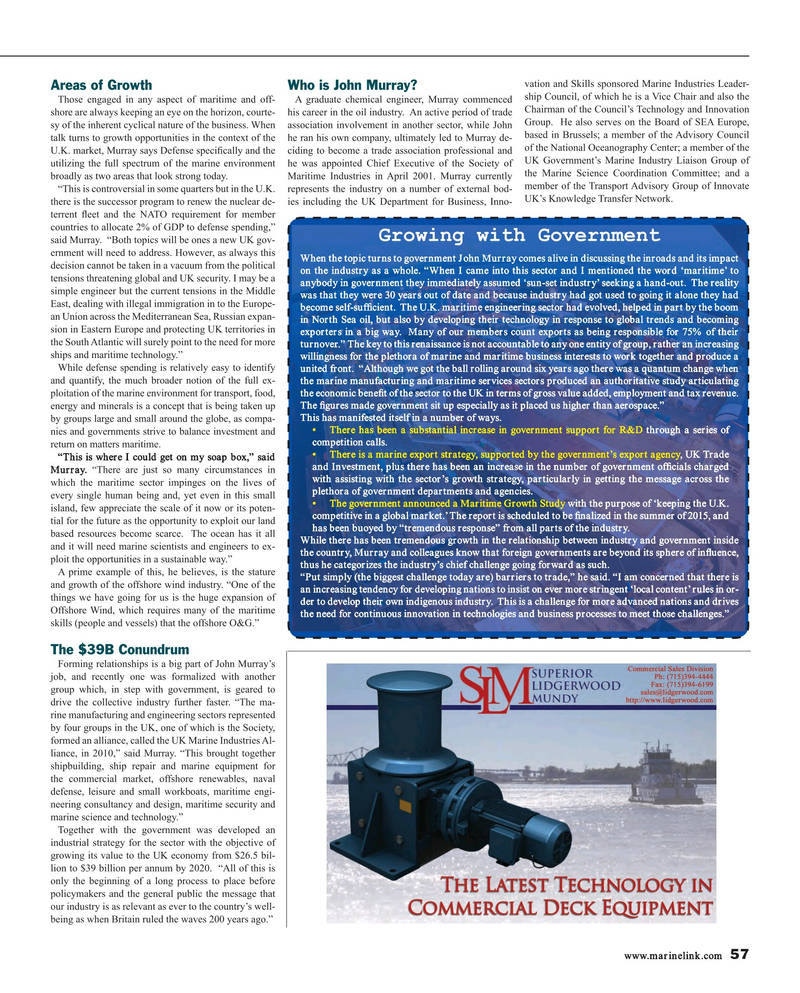
Page 57: of Maritime Reporter Magazine (June 2015)
Annual World Yearbook
Read this page in Pdf, Flash or Html5 edition of June 2015 Maritime Reporter Magazine
vation and Skills sponsored Marine Industries Leader-
Areas of Growth Who is John Murray?
Those engaged in any aspect of maritime and off- A graduate chemical engineer, Murray commenced ship Council, of which he is a Vice Chair and also the shore are always keeping an eye on the horizon, courte- his career in the oil industry. An active period of trade Chairman of the Council’s Technology and Innovation sy of the inherent cyclical nature of the business. When association involvement in another sector, while John Group. He also serves on the Board of SEA Europe, based in Brussels; a member of the Advisory Council talk turns to growth opportunities in the context of the he ran his own company, ultimately led to Murray de-
U.K. market, Murray says Defense speci? cally and the ciding to become a trade association professional and of the National Oceanography Center; a member of the utilizing the full spectrum of the marine environment he was appointed Chief Executive of the Society of UK Government’s Marine Industry Liaison Group of broadly as two areas that look strong today. Maritime Industries in April 2001. Murray currently the Marine Science Coordination Committee; and a member of the Transport Advisory Group of Innovate “This is controversial in some quarters but in the U.K. represents the industry on a number of external bod-
UK’s Knowledge Transfer Network. there is the successor program to renew the nuclear de- ies including the UK Department for Business, Inno- terrent ? eet and the NATO requirement for member countries to allocate 2% of GDP to defense spending,”
Growing with Government said Murray. “Both topics will be ones a new UK gov- ernment will need to address. However, as always this
When the topic turns to government John Murray comes alive in discussing the inroads and its impact decision cannot be taken in a vacuum from the political on the industry as a whole. “When I came into this sector and I mentioned the word ‘maritime’ to tensions threatening global and UK security. I may be a anybody in government they immediately assumed ‘sun-set industry’ seeking a hand-out. The reality simple engineer but the current tensions in the Middle was that they were 30 years out of date and because industry had got used to going it alone they had
East, dealing with illegal immigration in to the Europe- become self-suf? cient. The U.K. maritime engineering sector had evolved, helped in part by the boom an Union across the Mediterranean Sea, Russian expan- in North Sea oil, but also by developing their technology in response to global trends and becoming sion in Eastern Europe and protecting UK territories in exporters in a big way. Many of our members count exports as being responsible for 75% of their the South Atlantic will surely point to the need for more turnover.” The key to this renaissance is not accountable to any one entity of group, rather an increasing ships and maritime technology.” willingness for the plethora of marine and maritime business interests to work together and produce a
While defense spending is relatively easy to identify united front. “Although we got the ball rolling around six years ago there was a quantum change when and quantify, the much broader notion of the full ex- the marine manufacturing and maritime services sectors produced an authoritative study articulating ploitation of the marine environment for transport, food, the economic bene? t of the sector to the UK in terms of gross value added, employment and tax revenue. energy and minerals is a concept that is being taken up The ? gures made government sit up especially as it placed us higher than aerospace.”
This has manifested itself in a number of ways. by groups large and small around the globe, as compa- • There has been a substantial increase in government support for R&D through a series of nies and governments strive to balance investment and competition calls.
return on matters maritime.
• There is a marine export strategy, supported by the government’s export agency, UK Trade “This is where I could get on my soap box,” said and Investment, plus there has been an increase in the number of government of? cials charged
Murray. “There are just so many circumstances in with assisting with the sector’s growth strategy, particularly in getting the message across the which the maritime sector impinges on the lives of plethora of government departments and agencies.
every single human being and, yet even in this small • The government announced a Maritime Growth Study with the purpose of ‘keeping the U.K. island, few appreciate the scale of it now or its poten- competitive in a global market.’ The report is scheduled to be ? nalized in the summer of 2015, and tial for the future as the opportunity to exploit our land has been buoyed by “tremendous response” from all parts of the industry.
based resources become scarce. The ocean has it all
While there has been tremendous growth in the relationship between industry and government inside and it will need marine scientists and engineers to ex- the country, Murray and colleagues know that foreign governments are beyond its sphere of in? uence, ploit the opportunities in a sustainable way.” thus he categorizes the industry’s chief challenge going forward as such.
A prime example of this, he believes, is the stature “Put simply (the biggest challenge today are) barriers to trade,” he said. “I am concerned that there is and growth of the offshore wind industry. “One of the an increasing tendency for developing nations to insist on ever more stringent ‘local content’ rules in or- things we have going for us is the huge expansion of der to develop their own indigenous industry. This is a challenge for more advanced nations and drives
Offshore Wind, which requires many of the maritime the need for continuous innovation in technologies and business processes to meet those challenges.” skills (people and vessels) that the offshore O&G.”
The $39B Conundrum
Forming relationships is a big part of John Murray’s job, and recently one was formalized with another group which, in step with government, is geared to drive the collective industry further faster. “The ma- rine manufacturing and engineering sectors represented by four groups in the UK, one of which is the Society, formed an alliance, called the UK Marine Industries Al- liance, in 2010,” said Murray. “This brought together shipbuilding, ship repair and marine equipment for the commercial market, offshore renewables, naval defense, leisure and small workboats, maritime engi- neering consultancy and design, maritime security and marine science and technology.”
Together with the government was developed an industrial strategy for the sector with the objective of growing its value to the UK economy from $26.5 bil- lion to $39 billion per annum by 2020. “All of this is only the beginning of a long process to place before policymakers and the general public the message that our industry is as relevant as ever to the country’s well- being as when Britain ruled the waves 200 years ago.” www.marinelink.com 57
MR #6 (50-57).indd 57 MR #6 (50-57).indd 57 6/8/2015 3:23:27 PM6/8/2015 3:23:27 PM

 56
56

 58
58
